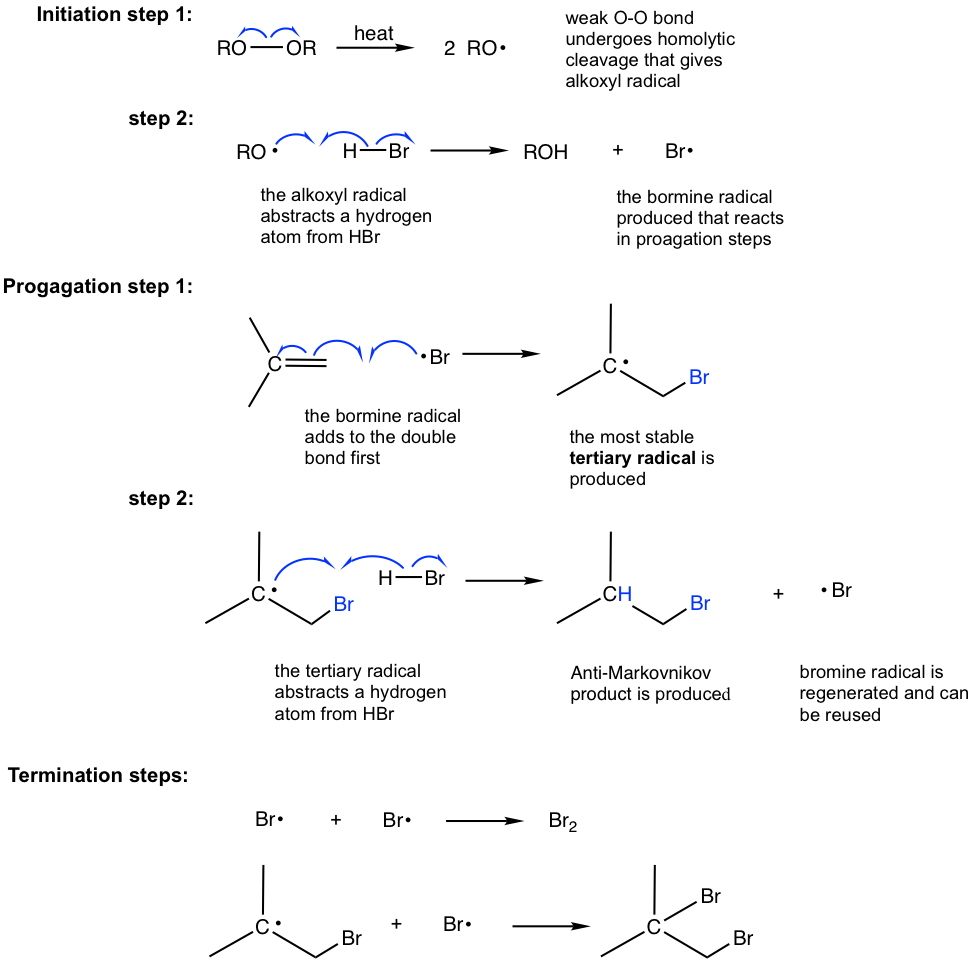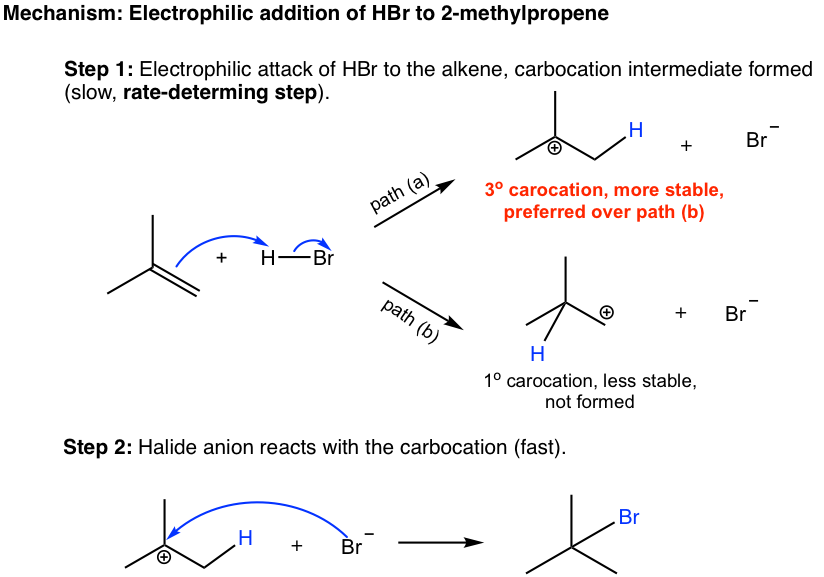Addition of Hydrogen Halides to Alkenes Mechanism
Hydrohalogenation is the addition of hydrogen halides such as HCl or HI to alkenes to yield the corresponding haloalkanes. Water hydrolysis will be favorable for 2º 3º-halides.

10 2 Reactions Of Alkenes Addition Of Hydrogen Halide To Alkenes Organic Chemistry I
Drawing alkene formulas from names.

. S N 1 S N 2 E1 E2 How to Choose the Mechanism. Alkenes react with water in the presence of acid as catalyst to form alcohols. A stereochemical study revesled.
Inversion results because the pyridine reacts with ROSOCl to give ROSONC 5 H 5 before anything further can take place. Secondary alcohols get oxidized to ketones and primary are oxidized to carboxylic acids by chromic acid. The addition of hydrogen bromide to 1butyne gives 2bromo1butene as the major product of the first step.
All these eliminations are β- eliminations. However often the two are used interchangeably because the. HBr and HCl to form alkyl halides.
Electrophilic addition to conjugated dienes occurs through 12 and 14-addition mechanism out of Q. CH 3 CHCH 2 HI CH 3 CHICH 2 H. The mechanism of alkyne hydrogenation is identical to that of the alkenes.
Drawing formulas from names. S N 1 S N 2 E1 or E2 the Largest Collection of Practice Problems. The elements of water can be added to the doublebonded carbons of an alkene in either a Markovnikovs or an antiMarkovnikovs manner.
Hindered halides is a challenge in organic synthesis. This concept of redox active ligands has resulted in new base metal catalysts for the asymmetric hydrogenation of alkenes as well as the hydrosilylation and hydroboration of olefins. Mechanism The mechanism of the reaction involves the following three steps.
3º-halides will probably give E2 elimination with nitrogen nucleophiles they are bases. The antiMarkovnikovs addition results from a hydroborationoxidation reaction. Drawing formulas from names.
In case of unsymmetrical alkenes the addition reaction takes place in accordance with Markovnikovs rule Unit 13 Class XI. Drawing formulas from names. Addition Reactions of Alkenes.
Formation of alkenes. From alkenes i By acid catalysed hydration. If the two carbon atoms at the double bond are linked to a different number of hydrogen atoms the halogen is found preferentially at the carbon with fewer hydrogen.
The addition of pyridine to the mixture of alcohol and thionyl chloride results in the formation of alkyl halide with inverted configuration. Acid-Catalyzed Hydration of Alkenes with Practice Problems. Primary aliphatic amines can be cleanly mono-alkylated by.
The bond angles are approximately 120 as expected of a trigonal coplanar structure Figure 121. Nitrogen and sulfur nucleophiles will give S N 2 substitution in the case of 1º and 2º-halides. It is a subset of reactions that very closely resembles the insertion reactions and both are differentiated by the mechanism that leads to the resulting stereochemistry of the products.
In addition the oxygen atom also has two non bonding electron pairs. Because the hydrogen is absorbed on the catalyst surface. Drawing alcohol formulas.
Hydrogen halides react with alkynes in the same manner as they do with alkenes. Given that i Ni0 complexes undergo oxidative addition more readily than NiI complexes with aryl halides and ii NiII complexes are believed to rapidly engage with sp 3 carbon-centered radicals to form NiIII species enabling sp 3 sp 2 and sp 3 sp 3 CC bond formations 15 16 we favor the dual-catalysis mechanism outlined. Evidence for this mechanism is as follows.
Thus the carbonyl carbon and the three atoms attached to it lie in the same plane and the π-electron cloud is above and below this plane. Benzyl C 6 H 5 CH 2. Oxidative addition of aryl and alkyl halides to a reduced iron pincer complex.
Preparation of Hydrocarbons Alkenes. Microwave heating enables a Borrowing Hydrogen strategy to form C-N bonds from alcohols and amines removes the need for solvent and reduces the reaction times while the results are comparable with those using thermal heating. Markovnikovs Rule with Practice Problems.
Alcohol dehydration is an example of an elimination reaction which is quite the opposite of substitution reaction and addition reaction. Delydrobalogenation of vinyi halides is essentially an E2 process. 1212 Structure of the Carbonyl.
C n H 2n. Matching alcohols to their names I. The Role of the Solvent in S N 1 S N 2 E1 and E2 Reactions.
There are 3 mechanisms suggested for the elimination reactions. In high dielectric ionizing solvents S N 1 and E1 products may be formed. Drawing alkyne formulas from names.
A migratory insertion is a type of reaction in organometallic chemistry wherein two ligands on a metal complex combine. As shown in the following figure a hydrogen ion catalyzes the Markovnikovs addition. Most of the reactions involving the preparation of alkenes involve elimination process.
Mechanism of Dehydration of Alcohols. A recent application is the generation of highly reactive aryl radicals which are useful arylating reagents in synthesis by photoinduced electron transfer PET from photoredox catalysts to suitable precursors followed by bond scission 8 9However the choice of aryl radical precursors is currently limited to electron-poor arenes such as diazonium 6 10 or.

Hydrohalogenation Of Alkenes Chemistry Chemistry Class Organic Chemistry

10 2 Reactions Of Alkenes Addition Of Hydrogen Halide To Alkenes Organic Chemistry I

Electrophilic Addition Reactions Of Alkenes Mcc Organic Chemistry

10 2 Reactions Of Alkenes Addition Of Hydrogen Halide To Alkenes Organic Chemistry I

9 2 Addition Of Hydrogen Halides To Symmetrical Alkenes Chemistry Libretexts

Electrophilic Addition Of Hydrogen Halides To Alkenes Youtube
0 Response to "Addition of Hydrogen Halides to Alkenes Mechanism"
Post a Comment